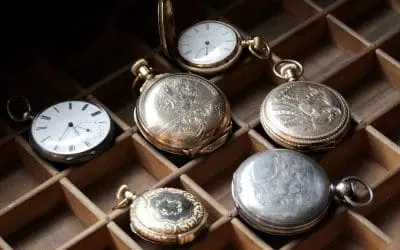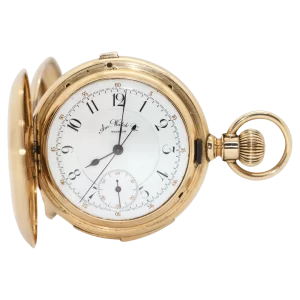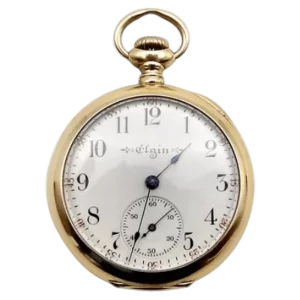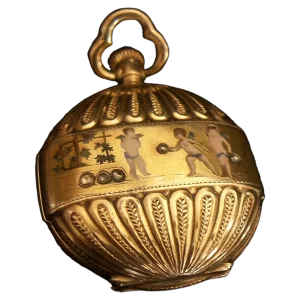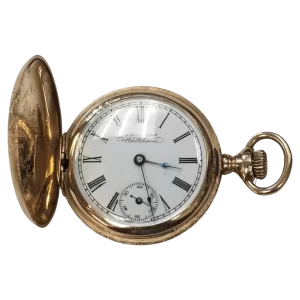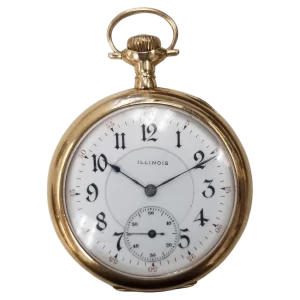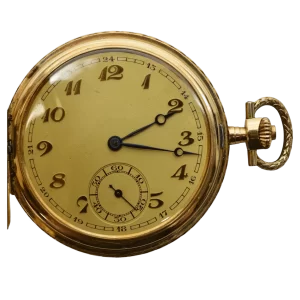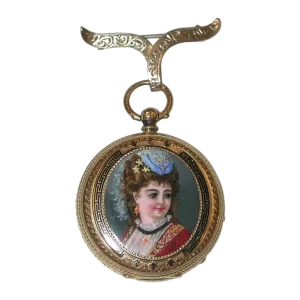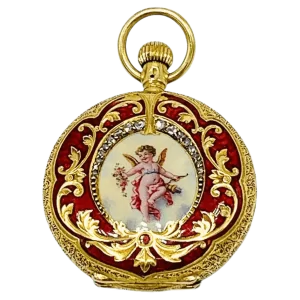Antique pocket watches have long been a significant element in the evolution of timekeeping and fashion, tracing their origins back to the 16th century. These small, portable timepieces, first crafted by Peter Henlein in 1510, revolutionized personal timekeeping by offering a compact alternative to the larger, stationary clocks of the era. Initially worn as pendants or attached to clothing, pocket watches evolved in design and functionality over the centuries. They transitioned from the heavy, drum-shaped ‘clock-watches’ of the 16th century to the more refined, rounded forms that fit neatly into waistcoat pockets by the 17th century. This transformation was spurred by advancements in watchmaking technology, such as the introduction of the cylinder escapement and later the lever escapement, which significantly improved accuracy. The American Watch Company, later known as Waltham, played a pivotal role in the mass production of pocket watches in the 19th century, making them more accessible and affordable. Despite being largely replaced by wristwatches and digital devices in the 20th century, antique pocket watches remain highly valued by collectors and enthusiasts for their historical significance, intricate craftsmanship, and the elegance they bring to horological history.
Pocket watches have been an important part of modern civilization and developments in the watch world. Ever since the 16th Century, they have been an integral part of male fashion. These small, round timepieces represented portable clocks and were a status symbol until mass production became easy.
BACKGROUND :
The first pocket watch was invented by Peter Henlein in 1510 in Nuremberg, Germany. The Italians were producing clocks small enough to be worn on the person by the early 16th century. The first pocket watch was invented by a German watchmaker named Peter Henlein in 1510. By utilizing the recent advancements in mainsprings, Peter was able to create a smaller watch design that was not possible before. This first model was much smaller than any other timepieces and was compact enough to be worn Feb 14, 2020.
The first timepieces to be worn, made in 16th-century Europe, were transitional between clocks and watches. These ‘clock-watches’ were fastened to clothing or worn on a chain around the neck. They were heavy drum shaped brass cylinders several inches in diameter, engraved and ornamented. They had only an hour hand. The face was not covered with glass, but usually had a hinged brass cover, often decoratively pierced with grill work, so the time could be read without opening. The movement was made of iron or steel and held together with tapered pins and wedges, until screws began to be used after 1550.
Many of the movements included striking or alarm mechanisms. The shape later evolved into a rounded form; these were later called Nuremberg eggs. Still later in the century there was a trend for unusually shaped watches, and clock-watches shaped like books, animals, fruit, stars, flowers, insects, crosses, and even skulls (Death’s head watches) were made.
Styles changed in the 17th century and men began to wear watches in pockets instead of as pendants (the woman’s watch remained a pendant into the 20th century). This is said to have occurred in 1675 when Charles II of England introduced waistcoats. To fit in pockets, their shape evolved into the typical pocket watch shape, rounded and flattened with no sharp edges. Glass was used to cover the face beginning around 1610. Watch fobs began to be used, the name originating from the German word fuppe, a small pocket.[5] The watch was wound and also set by opening the back and fitting a key to a square arbor, and turning it.
Until the second half of the 18th century, watches were luxury items; as an indication of how highly they were valued, English newspapers of the 18th century often include advertisements offering rewards of between one and five guineas merely for information that might lead to the recovery of stolen watches. By the end of the 18th century, however, watches (while still largely hand-made) were becoming more common; special cheap watches were made for sale to sailors, with crude but colorful paintings of maritime scenes on the dials.
Up to the 1720s, almost all watch movements were based on the verge escapement, which had been developed for large public clocks in the 14th century. This type of escapement involved a high degree of friction and did not include any kind of jewelling to protect the contacting surfaces from wear. As a result, a verge watch could rarely achieve any high standard of accuracy. (Surviving examples mostly run very fast, often gaining an hour a day or more.) The first widely used improvement was the cylinder escapement, developed by the Abbé de Hautefeuille early in the 18th century and applied by the English maker George Graham. Then, towards the end of the 18th century, the lever escapement (invented by Thomas Mudge in 1755) was put into limited production by a handful of makers including Josiah Emery (a Swiss based in London) and Abraham-Louis Breguet. With this, a domestic watch could keep time to within a minute a day. Lever watches became common after about 1820, and this type is still used in most mechanical watches today.
In 1857 the American Watch Company in Waltham, Massachusetts introduced the Waltham Model 57, the first to use interchangeable parts. This cut the cost of manufacture and repair. Most Model 57 pocket watches were in a coin silver (“one nine fine”), a 90% pure silver alloy commonly used in dollar coinage, slightly less pure than the British (92.5%) sterling silver, both of which avoided the higher purity of other types of silver to make circulating coins and other utilitarian silver objects last longer with heavy use.
Watch manufacture was becoming streamlined; the Japy family of Schaffhausen, Switzerland, led the way in this, and soon afterwards the newborn American watch industry developed much new machinery, so that by 1865 the American Watch Company (afterwards known as Waltham) could turn out more than 50,000 reliable watches each year. This development drove the Swiss out of their dominating position at the cheaper end of the market, compelling them to raise the quality of their products and establish themselves as the leaders in precision and accuracy instead.
METHODOLOGY :
Pocket watches have five primary mechanical components: a mainspring, a gear train, a balance wheel, an escapement mechanism and a clock face. The mainspring gets compressed when a pocket watch is wound, and the mechanical energy produced is used to power the watch Oct 21, 2015. The true value of a pocket watch depends on a few factors. Age, rarity and brand will all affect the sale price. Chiefly, the brand name will represent most of the watch’s value – good pocket watch brands can sell for several thousand pounds.
RESULTS :
For some 400 years, the pocket watch was the most popular form of portable timepiece, only surpassed by the wristwatch in the 20th century. From the 16th century onwards, the pocket watch became an essential accessory for men, being both practical and fashionable with the development of elegant designs. Traditionally, the pocket watch is fastened to a chain, enabling the clock to be worn as a necklace or secured to a part of clothing. Whilst Europe has been manufacturing since the 1500s, the first American pocket watches were not produced until the 1800s. Despite the slow advancement in the States, the Waltham Watch Company of Massachusetts were the first to develop pocket watches with interchangeable parts, both speeding up the process of manufacturing as well as reducing the cost. Waltham pocket watches are still highly coveted by horological enthusiasts today, with many being sold by dealers and at auction.
CONCLUSION :
Pocket watches are uncommon in the present day, having been superseded by wristwatches and smartphones. Until early in the 20th century, though, the pocket watch remained predominant for men, with the wristwatch considered feminine and unmanly. In men’s fashions, pocket watches began to be superseded by wristwatches around the time of World War I, when officers in the field began to appreciate that a watch worn on the wrist was more easily accessed than one kept in a pocket. A watch of transitional design, combining features of pocket watches and modern wristwatches, was called a “trench watch” or “wristlet”. The more accurate pocket watches continued to be widely used in railroading even as their popularity declined elsewhere.
The widespread use of pocket watches in a professional environment finally came to an end in approximately 1943. The Royal Navy of the British military distributed to their sailors Waltham pocket watches, which were nine-jewel movements, with black dials, and numbers coated with radium for visibility in the dark, in anticipation of the eventual D-Day invasion. For a few years in the late 1970s and 1980s three-piece suits for men returned to fashion, and this led to small resurgence in pocket watches, as some men actually used the vest pocket for its original purpose. Since then, some watch companies continue to make pocket watches. As vests have long since fallen out of fashion (in the US) as part of formal business wear, the only available location for carrying a watch is in a trouser pocket. The more recent advent of mobile phones and other gadgets that are worn on the waist has diminished the appeal of carrying an additional item in the same location, especially as such pocketable gadgets usually have timekeeping functionality themselves.
In some countries a gift of a gold-cased pocket watch is traditionally awarded to an employee upon their retirement. The pocket watch has regained popularity in the steampunk subcultural movement embracing the arts and fashions of the Victorian era, during which pocket watches were nearly ubiquitous.
BIBLIOGRAPHY :
Milham, Willis I (1945), Time and Timekeepers, New York: MacMillan, ISBN 0-7808-0008-7.


